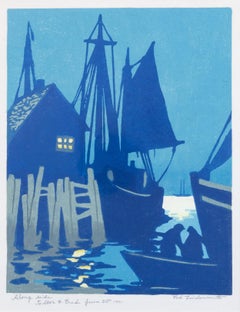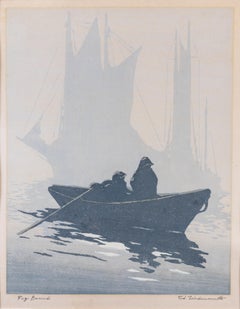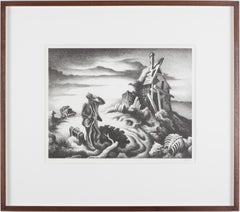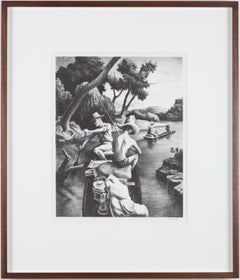Tod Lindenmuth Prints and Multiples
Tod Lindenmuth was a semi-abstract painter and graphic artist who did much to promote modernist styles. Although he was much influenced by Abstract Expressionism, his subject matter was realistic enough to be recognizable. He did linoleum cuts and was one of the first to work with that medium, and towards the end of his life, he experimented with collage. In the 1930s, he had commissions for the Public Works of Art Project and the Works Progress Administration. Lindenmuth was born in Allentown, Pennsylvania. He studied with Robert Henri at the New York School of the Arts in Manhattan, and in Provincetown with E. Ambrose Webster and George Elmer Browne. He first exhibited in Provincetown in 1915 and between 1917 and 1928 served on the jury for the Provincetown Art Association’s "First Modernistic Exhibition.” He exhibited regularly with the Society of Independent Artists in New York. He married artist and illustrator Elizabeth Boardman Warren, whom he met in Provincetown, and with whom he had two children. They were both very active in Provincetown, but in 1934, they visited St. Augustine, Florida, for the first time and went on to establish a winter studio in the Fatio House on Aviles Street and became active and respected members of the arts community there. In 1940, the couple moved permanently to St. Augustine. They never owned a car and sought subjects on long walks around St. Augustine. In 1940, Lindenmuth turned away from graphic arts and focused on landscape painting. One of his landscapes, Spanish Cedar and Live Oak along the Moat, St. Augustine, depicted a huge tree on a historic site whose excavations showed that St. Augustine had an early role in validating Spanish claims to North America. In 1940, the Lindenmuth's moved their summer studio from Provincetown to Rockport, Massachusetts, and became regular exhibitors of the Rockport Artist Association. He once said, “the marine subjects of Provincetown and Rockport, Massachusetts, are favorite painting spots but the landscape of the South with its subtle and tropical aspects furnishes a lot of material for the artist, particularly around St. Augustine.” For the remainder of their painting careers, they divided their time seasonally between Rockport and St. Augustine. In 1968, they retired to Jacksonville, Florida, living in Wesley Manor (Westminster Woods) on Julington Creek. Lindenmuth died in Jacksonville in 1976 at age 91.
1940s American Modern Tod Lindenmuth Prints and Multiples
Color
Mid-20th Century American Modern Tod Lindenmuth Prints and Multiples
Color
1930s American Modern Tod Lindenmuth Prints and Multiples
Lithograph
1930s American Modern Tod Lindenmuth Prints and Multiples
Lithograph
1960s American Modern Tod Lindenmuth Prints and Multiples
Offset
1950s American Modern Tod Lindenmuth Prints and Multiples
Offset
1960s American Modern Tod Lindenmuth Prints and Multiples
Offset
1950s American Modern Tod Lindenmuth Prints and Multiples
Offset
1990s American Modern Tod Lindenmuth Prints and Multiples
Offset
1950s American Modern Tod Lindenmuth Prints and Multiples
Offset
1940s American Modern Tod Lindenmuth Prints and Multiples
Offset
1940s American Modern Tod Lindenmuth Prints and Multiples
Offset
1970s American Modern Tod Lindenmuth Prints and Multiples
Offset
1960s American Modern Tod Lindenmuth Prints and Multiples
Offset



